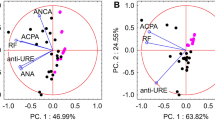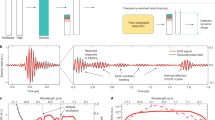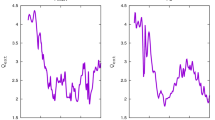Abstract
IN a recent report1 the spectra of various dipeptides in the isoionic, basic, and acidic states in water were examined by transmission techniques with ‘Irtran-2’ cells, and the use of such spectra for structural and identification purposes was discussed. A drawback of the method used is that no information can be obtained in areas where water absorbs very strongly. This is particularly true around 6µ (∼ 1,660 cm−1), where amino-acids and peptides should show characteristic bands. The principle of attenuated total reflectance2 has enabled the examination of even comparatively weak absorption bands and has permitted spectra to be obtained on difficult samples. Spectra of sucrose in water and of whole blood have been shown by manufacturers of infra-red equipment.
This is a preview of subscription content, access via your institution
Access options
Subscribe to this journal
Receive 51 print issues and online access
$199.00 per year
only $3.90 per issue
Buy this article
- Purchase on Springer Link
- Instant access to full article PDF
Prices may be subject to local taxes which are calculated during checkout
Similar content being viewed by others
References
Parker, F. S., Fed. Proc., 22, 478 (1963). Spectral data were presented in Atlantic City, New Jersey, April 18, 1963, at the meeting of the Fed. Amer. Soc. Exp. Biol.
Fahrenfort, J., Spectrochim. Acta, 17, 698 (1961). The author states, “The similarity between the new ATR spectra and transmission spectra is so great in all cases investigated that probably the collections of standard transmission spectra can also be used as a reference for identification by means of the reflection spectra”.
Similar absorption was found at 1,400 cm−1 in the Raman spectrum of glycylglycine. Edsall, J. T., Otvos, J. W., and Rich, A., J. Amer. Chem. Soc., 72, 474 (1950).
Ellenbogen, E., J. Amer. Chem. Soc., 78, 363 (1956).
Thompson, H. W., Nicholson, D. L., and Short, L. N., Disc. Farad. Soc., 9, 222 (1950).
Blout, E. R., and Linsley, S. G., J. Amer. Chem. Soc., 74, 1946 (1952).
Bellamy, L. J., The Infra-red Spectra of Complex Molecules, second ed., 162, 224 (Methuen, London, 1958).
Author information
Authors and Affiliations
Rights and permissions
About this article
Cite this article
PARKER, F. Attenuated Total Reflectance Spectra of Glycyl-L-alanine in Aqueous Solutions. Nature 200, 1093–1094 (1963). https://doi.org/10.1038/2001093a0
Issue Date:
DOI: https://doi.org/10.1038/2001093a0
This article is cited by
-
Spectrophotometry by perturbed total internal reflection
Journal of Applied Spectroscopy (1967)
-
Infra-red Spectra of Aqueous Solutions by the Attenuated Total Reflectance Technique
Nature (1964)
Comments
By submitting a comment you agree to abide by our Terms and Community Guidelines. If you find something abusive or that does not comply with our terms or guidelines please flag it as inappropriate.



